Great Nebraska
Naturalists and Scientists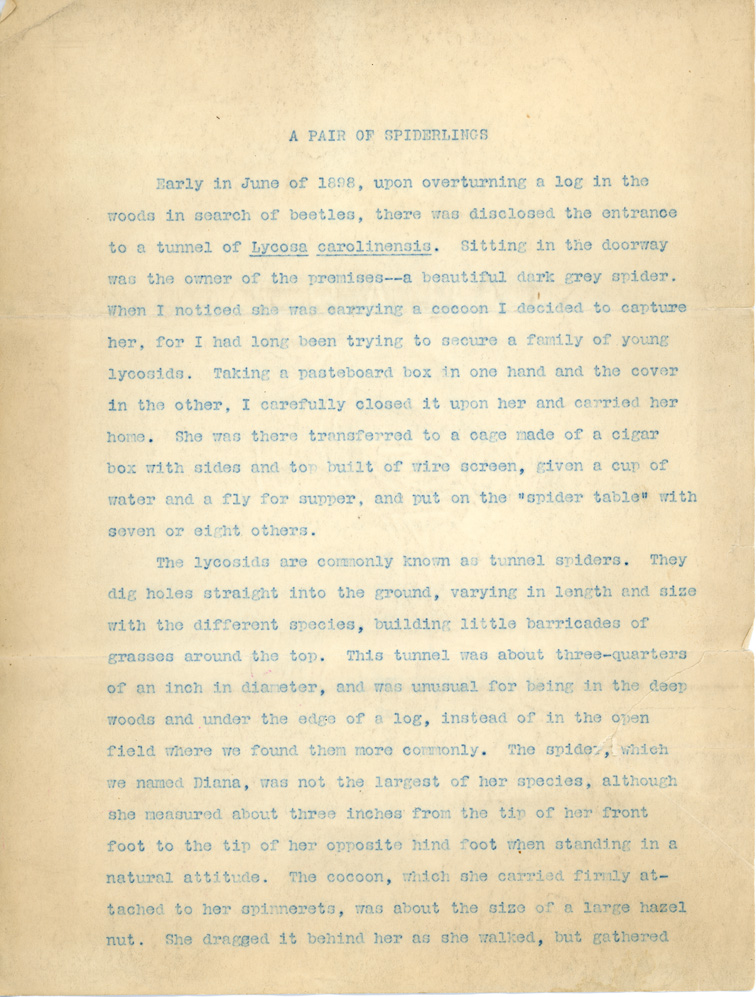
A PAIR OF SPIDERLINGS
Early in June of 1898, upon overturning a log in the woods in search of beetles, there was disclosed the entrance to a tunnel of Lycosa carolinensis. Sitting in the doorway was the owner of the premises—a beautiful dark grey spider. When I noticed she was carrying a cocoon I decided to capture her, for I had long been trying to secure a family of young lycosids. Taking a pasteboard box in one hand and the cover in the other, I carefully closed it upon her and carried her home. She was there transferred to a cage made of a cigar box with sides and top built of wire screen, given a cup of water and a fly for supper, and put on the “spider table” with seven or eight others.
The lycosids are commonly known as tunnel spiders. They dig holes straight into the ground, varying in length and size with the different species, building little barricades of grasses around the top. This tunnel was a about three-quarters of an inch in diameter, and was unusual for being in the deep woods and under the edge of a log, instead of in the open field where we found them more commonly. The spider, which we named Dianna, was not the largest of her species, although she measured about three inches from the tip of her front foot to the tip of her opposite hind foot when standing in a natural attitude. The cocoon, which she carried firmly attached to her spinnerets, was about the size of a large hazel nut. She dragged it behind her as she walked but gathered
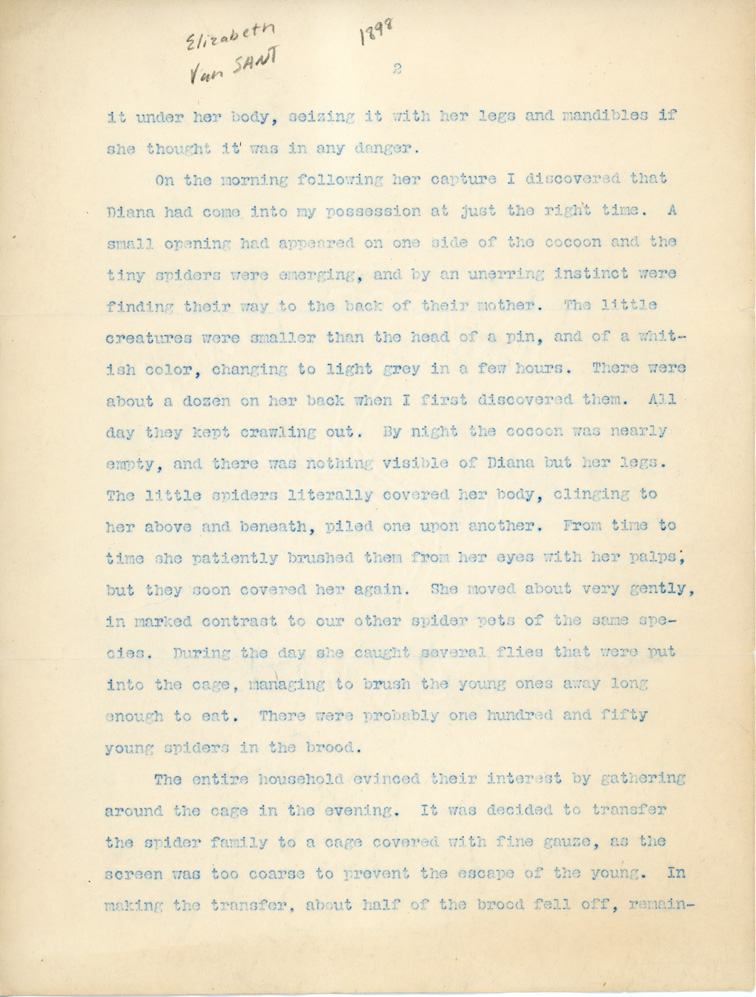
(Handwritten script) Elizabeth Van Sant 1898
2
it under her body, seizing it with her legs and mandibles if she thought it was in any danger.
On the morning following her capture I discovered that Dianna had come into my possession at just the right time. A small opening had appeared on one side of the cocoon and the tiny spiders were emerging, and by an unerring instinct were finding their way to the back of their mother. The little creatures were smaller than the head of a pin, and of a whitish color, changing to light grey in a few hours. There were about a dozen on her back when I first discovered them. All day they kept crawling out. By night the cocoon was nearly empty, and there was nothing visible of Dianna but her legs. The little spiders literally covered her body, clinging to her above and beneath, piled one upon another. From time to time she patiently brushed them from her eyes with her palps, but they soon covered he again. She moved about very gently, in marked contrast to out other spider pets of the same species. During the day she caught several flies that were put into the cage, managing to brush the young ones away long enough to eat. There were probably one hundred and fifty young spiders in the brood.
The entire household evinced their interest by gathering around the cage in the evening. It was decided to transfer the spider family to a cage covered with fine gauze, as the screen was too coarse to prevent the escape of the young. In making the transfer, about half of the brood fell off, remain-
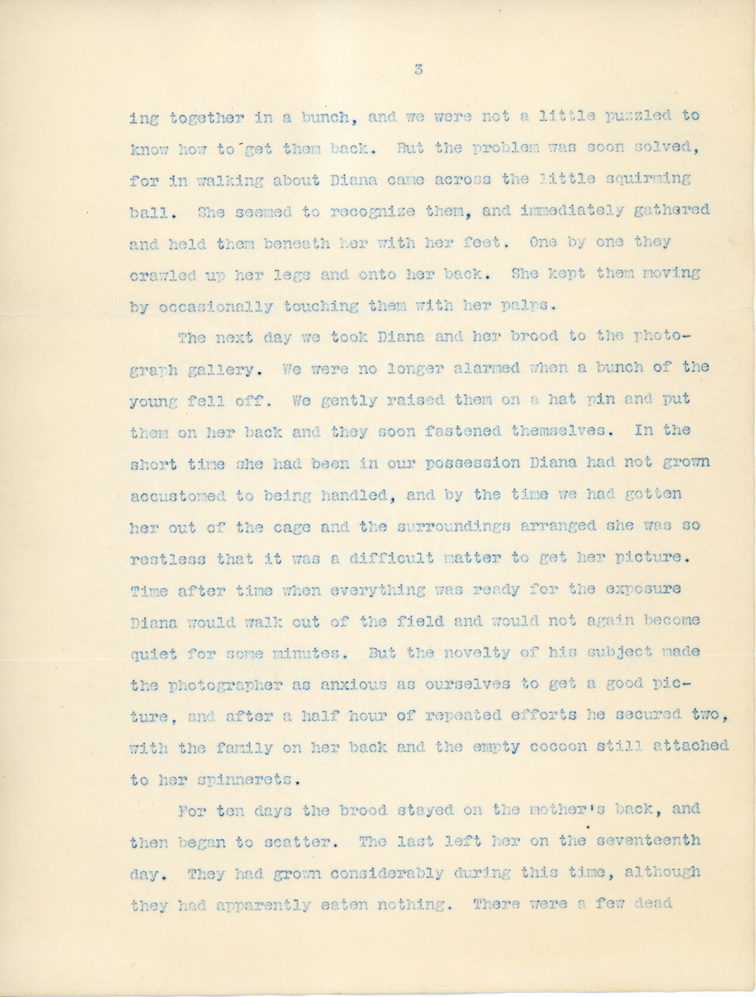
3
ing together in a bunch, and we were not a little puzzled to know how to get them back. But the problem was soon solved, for in walking about Diana came across the little squirming ball. She seemed to recognize them, and immediately gathered and held them beneath her with her feet. One by one they crawled up her legs and onto her back. She kept thme moving by occasionally touching them with her palps.
The next day we took Diana and her brood to the photograph gallery. We were no longer alarmed when a bunch of the young fell off. We gently raised them on a hat pin and put them on her back and they soon fastened themselves. In the short time she had been in our possession Diana had not grown accustomed to being handled, and by the tie we had gotten her out of the cage and the surroundings arranged she was so restless that it was a difficult matter to get her picture. Time after time when everything was ready for the exposure Diana would walk out of the field and would not again become quiet for some minutes. But the novelty of his subject made the photographer as anxious as ourselves to get a good picture, and after a half hour of repeated efforts he secured two, with the family on her back and the empty cocoon still attached to her spinnerets.
For ten days the brood stayed on the mother’s back, and then began to scatter. The last left her on the seventeenth day. They had grown considerably during this time, although they had apparently eaten nothing. There were a few dead

4
ones in the cage, but there was no evidence that they had fed upon each other. As soon as they started out in life for themselves they began to creep through the meshes of the gauze, stretching little lines of web all over the table and its surroundings, crawling about the bay window and gradually disappearing. A few remained with the mother, and we thought had grown so large that they could not escape; but on the morning they were four weeks old I discovered that there was only one left in the cage. While I was looking at him he squeezed his way through a little hole and started out on an independent career; but I promptly thwarted that ambition and put him into a small box with a double gauze cover, determined to keep him if possible. We named him Robinson Crusoe—the sole survivor. He had grown until his feet covered a circle a quarter of an inch in diameter, and still he had seemingly eaten nothing. I killed a fly and put it into his box and he seized and dragged it about with a great show of valor, though he could not possibly have killed it. Three or four days of feeding made great changes in Robinson, and before the end of his fifth week he was able to catch and kill a fly when it was put into his cage. He would sometimes have a great battle, for his body was much smaller than the fly; but his eight slender legs were a help in holding his prey, and he seemed to have unlimited courage. He drank much more frequently than the mature spiders.
The day he was five weeks old Robinson shed his skin,
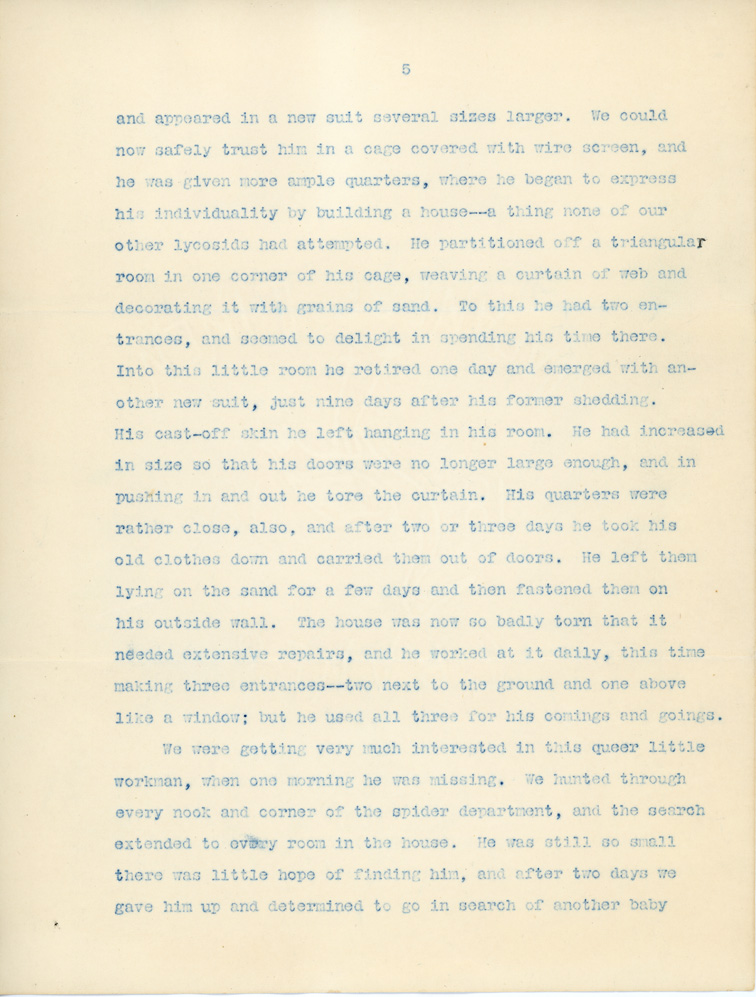
5
and appeared in a new suit several sizes larger. We could now safely trust him in a cage covered with wire screen, and he was given more ample quarters, where he began to express his individuality by building a house—a thing none of our other lycosids had attempted. He partitioned off a triangular room in one corner of his cage, weaving a curtain of web and decorating it with grains of sand. To this he had two entrances, and seemed to delight in spending his time there. Into this little room he retired one day and emerged with another new suit, just nine days after his former shedding. His cast-off skin he left hanging in his room. He had increased in size so that his doors were no longer large enough, and in pushing in and out he tore the curtain. His quarters were rather close, also, and after two or three days he took his old clothes down and carried them out of doors. He left them lying on the sand for a few days and then fastened them on his outside wall. The house was now so badly torn that it needed extensive repairs, and he worked at it daily, this time making three entrances—two next to the ground and one above like a window; but he used all three for his comings and goings.
We were getting very much interested in this queer little workman, when one morning he was missing. We hunted through every nook and corner of the spider department, and the search extended to every room in this house. He was still so small there was little hope of finding him, and after two days we gave him up and determined to go in search of another baby
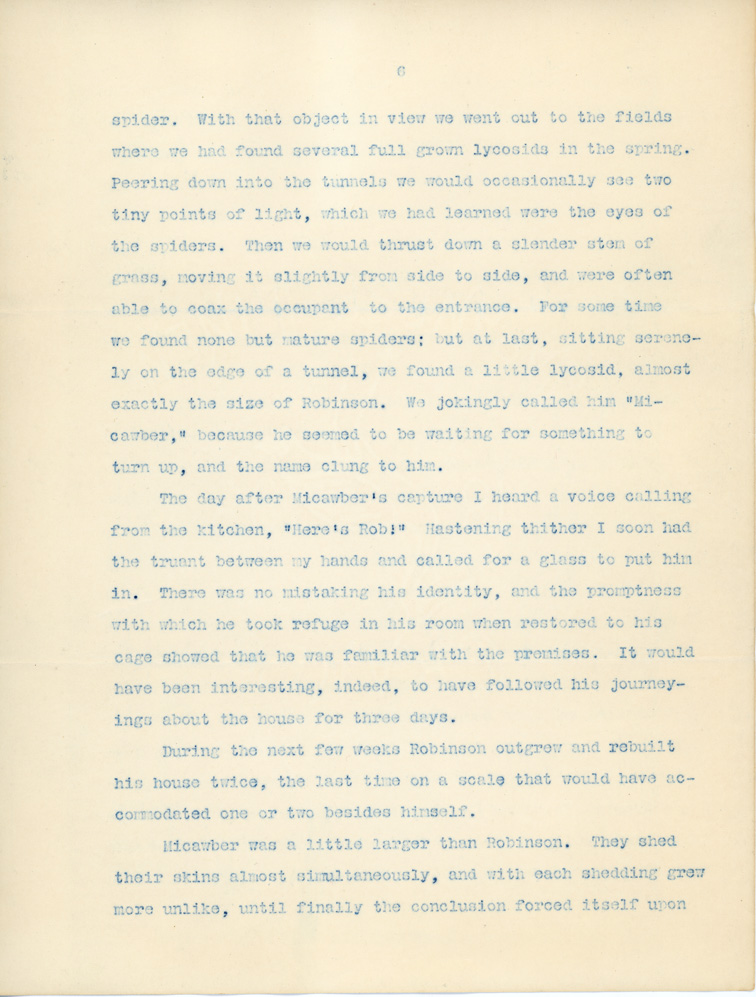
6
spider. With that object in view we went ou to the fields where we had found several full grown lycosids in the spring. Peering down into tunnels we would occasionally see two tiny points of light, which we had learned were the eyes of the spiders. When we would thrust down a slender stem of grass, moving it slightly from side to side, and were often able to coax the occupant to the entrance. For some time we found none but mature spiders; but at last, sitting serenely on the edge of a tunnel, we found a little lycosid, almost exactly the size of Robinson. We jokingly called him “Midcawber,” because he seemed to be waiting for something to turn up, and the name clung to him.
The day after Micawber’s capture I heard a voice calling from the kitchen, “Here’s Rob!” Hastening thither I soon had the truant between my hands and called for a glass to put him in. There was no mistaking his identity, and the promptness with which he took refuge in his room when restored to his cage showed that he was familiar with the premises. It would have been interesting, indeed, to have followed his journeyings about the house for three days.
During the next few weeks Robinson outgrew and rebuilt his house twice, the last time on a scale that would have accommodated one or two besides himself.
Micawber was a little larger than Robinson. They shed their skins almost simultaneously, and with each shedding grew more unlike, until finally the conclusion forced itself upon
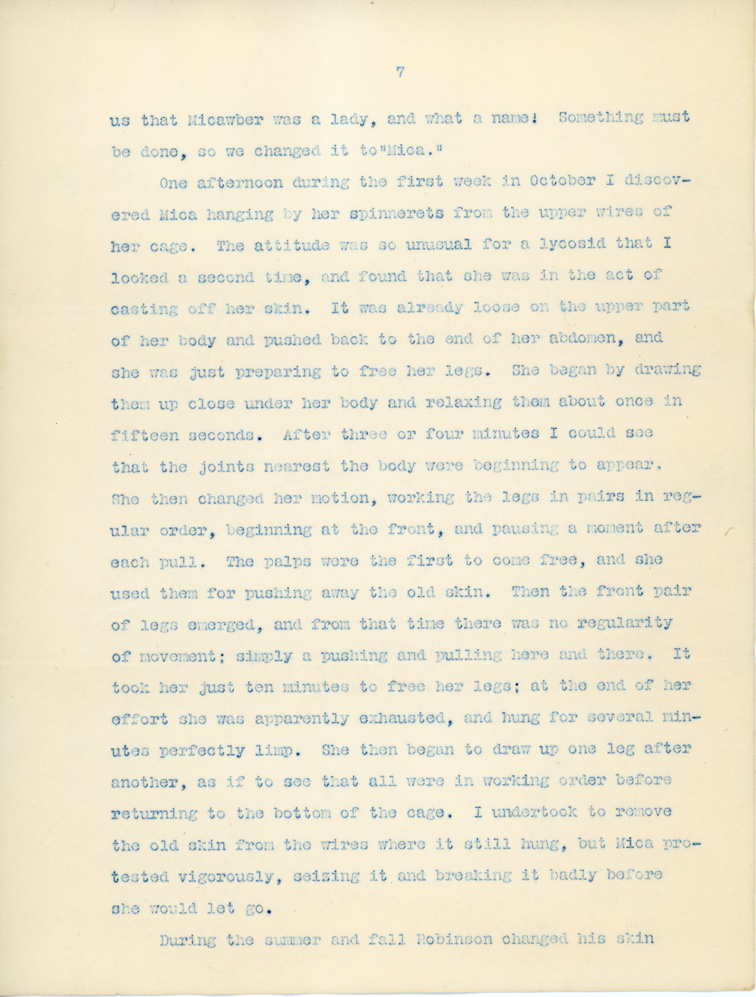
7
us that Micawber was a lady, and what name! Something must be done, so we changed it to “Mica.”
One after afternoon during the first week in October I discovered Mica hanging by her spinnerets from the upper wires of her cage. The attitudes was so unusual for a lycosid that I looked a second time, and found that she was in the act of casting off her skin. It was already loose on the upper part of her body and pushed back to the end of her abdomen, and she was just preparing to free her legs. She began by drawing hem up close under her body and relaxing them about once in fifteen seconds. After three or four minutes I could see that the joints nearest the body were beginning to appear. She then changed her motion, working the legs in pairs in regular order, beginning at the front, and pausing a moment after each pull. The palps were the first to come free, and she used them for pushing away the old skin. Then the front pair of legs emerged, and from that time there was no regularity of movement; simply a pushing and pulling here and there. It took her just ten minutes to free her legs; at the end of her effort she was apparently exhausted, and hung for several minutes perfectly limp. She then began to draw up one leg after another, as if to see that all were in working order before returning to the bottom of the cage. I undertook to remove the old skin from the wires where it still hung, but Mica protested vigorously, seizing it and breaking it badly before she would let go.
During the summer and fall Robinson changed his skin
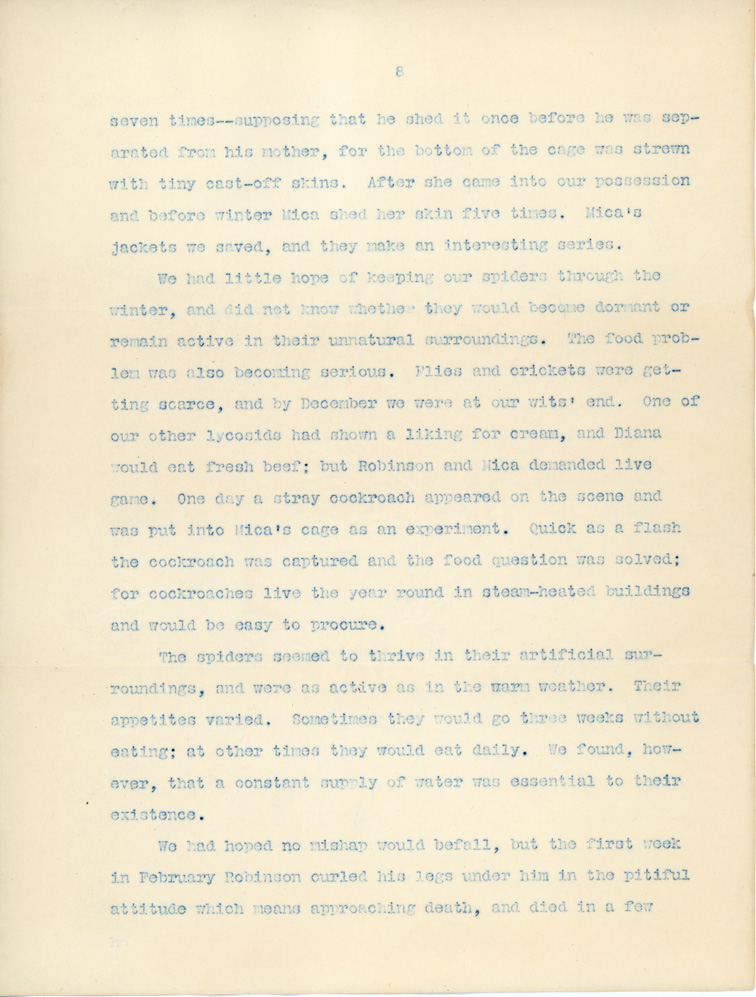
8
seven times—supposing that he shed it once before he was separated from his mother, for the bottom of the cage was strewn with tiny cast-off skins. After she came into our possession and before winter Mica shed her skin five times. Mica’s jackets we saved, and they make an interesting series.
We had little hope of keeping our spiders through the winter, and did not know whether they would become dormant or remain active in their unnatural surroundings. The food problem was also becoming serious. Flies and crickets were getting scarce, and by December we were at our wits’ end. One of our other lycosids had shown a liking for cream, and Diana would eat fresh beef; but Robinson and Mica demanded live game. One day a stray cockroach appeared on the scene and was put into Mica’s cage as an experiment. Quick as a flash the cockroaches live the year round in steam-heated buildings and would be easy to procure.
The spiders seemed to thrive in their artificial surroundings, and were as active as in the warm weather. Their appetites varied. Sometimes they would go three weeks without appetites varied. Sometimes they would go three weeks without eating; at other times they would eat daily. We found, however, that a constant supply of water was essential to their existence.
We had hoped no mishap would befall, but the first week in February Robinson curled his legs under him in the pitiful attitude which means approaching death, and died in a few
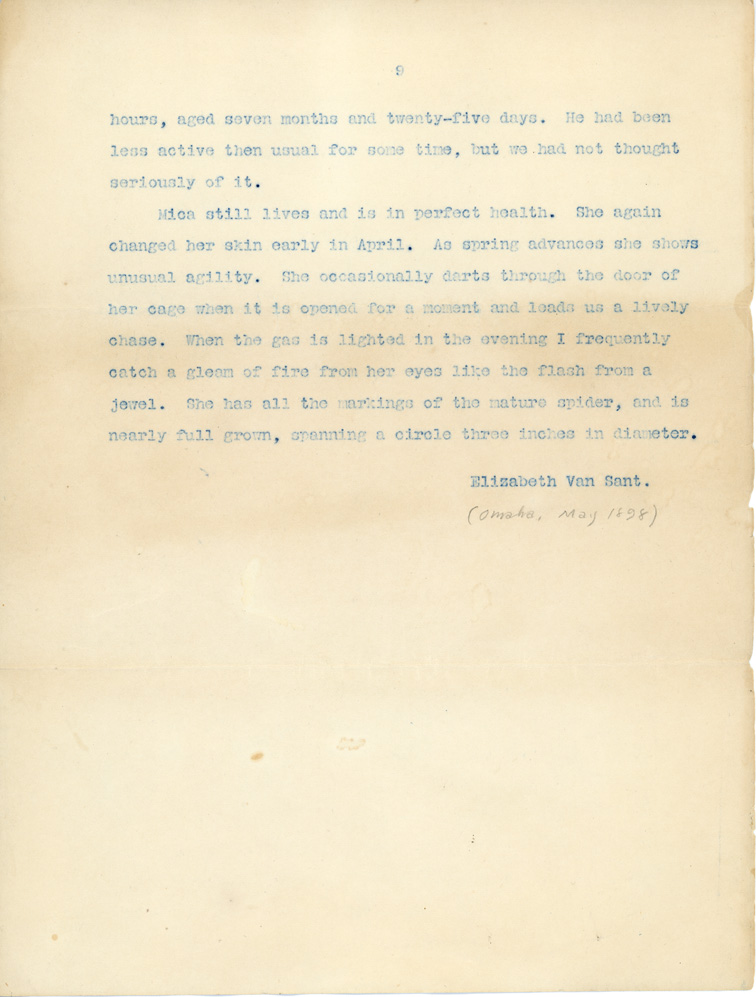
9
hours, aged seven months and twenty-five days. He had been less active then usual for some time, but we had not thought seriously of it.
Mica still lives and is in perfect health. She again changed her skin early in April. As spring advances she shows unusual agility. She occasionally darts through the door of her cage when it is opened for a moment and leads us a lively chase. When the gas is lighted in the evening I frequently catch a gleam of fire from her eyes like the flash from a jewel. She has all the markings of a mature spider, and is nearly full grown, spanning a circle three inches in diameter.
Elizabeth Van Sant.
[handwritten script] (Omaha, May 1898)